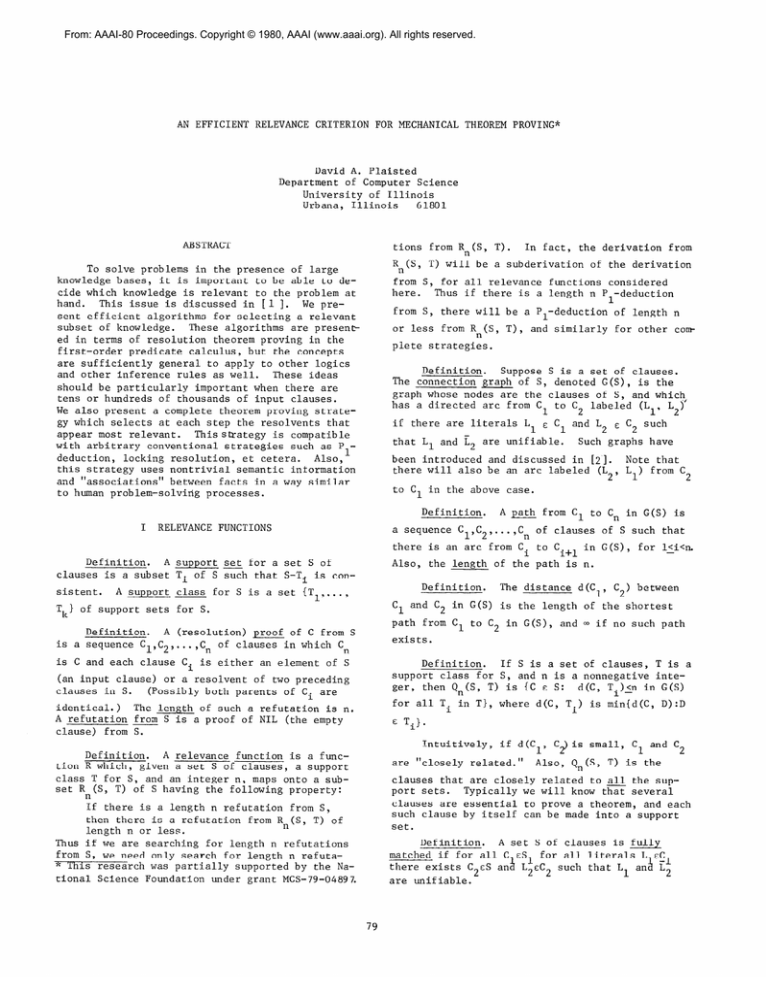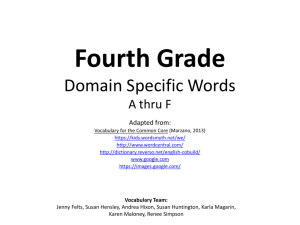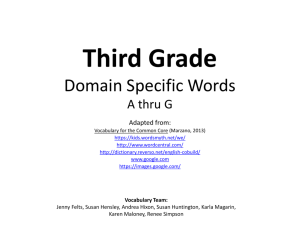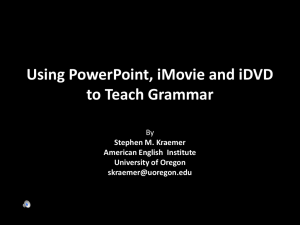
From: AAAI-80 Proceedings. Copyright © 1980, AAAI (www.aaai.org). All rights reserved.
AN EFFICIENT
RELEVANCE
CRITERION
THEOREM
FOR MECHANICAL
PROVING*
David A. Plaisted
Department of Computer Science
University of Illinois
Urbana, Illinois
61801
ABSTRACT
To solve problems in the presence of large
knowledge bases, it is important to be able to decide which knowledge is relevant to the problem at
This issue is discussed in [l 1. We prehand.
sent efficient algorithms for selecting a relevant
These algorithms are presene
subset of knowledge.
ed in terms of resolution theorem proving in the
first-order predicate calculus, but the concepts
are sufficiently
general to apply to other logics
and other inference rules as well.
These ideas
should be particularly
important when there are
tens or hundreds of thousands of input clauses.
We also present a complete theorem proving strategy which selects at each step the resolvents that
Thisstrategy
is compatible
appear most relevant.
with arbitrary conventional strategies such as P 1
Also,
deduction, locking resolution, et cetera.
this strategy uses nontrivial semantic information
and "associations"
between facts in a way similar
to human problem-solving
processes.
tions
from R,(S,
R,(S,
T) will
RELEVANCE
A support
Tk] of support
sets
class
of length
n
or less from R,(S,
T), and similarly
for other
corn
strategies.
Definition.
Suppose S is a set of clauses.
The connection graph of S, denoted G(S), is the
graph whose nodes are the clauses of S, and which
has a directed arc from C to C 2 labeled (Ll, L2)'
1
if there are literals L 1 c C 1 and L2 E C2 such
that Ll and z2 are unifiable.
FUNCTIONS
a sequence
of S such
is an arc from C i to c i+l in G(S),
the length
Cl and C2 in G(S)
an element
have
from Cl to Cn in G(S)
there
Definition.
for S.
A path
Cl,C2,..., Cn of clauses
Also,
for S is a set {Tl,...,
C i is either
Such graphs
been introduced and discussed in [2]. Note that
there will also be an arc labeled (L
Ll> from C
2'
2
to Cl in the above case.
Definition.
A (resolution) proof of C from S
is a sequence C1,C2 ,...,C, of clauses in which Cn
clause
from
of the derivation
be a P l-deduction
path
is C and each
the derivation
from S, there will
plete
Definition.
A support set for a set S of
clauses is a subset Ti of S such that S-Ti is consistent.
In fact,
from S, for all relevance functions considered
Thus if there is a length n P1-deduction
here.
Definition.
I
T).
be a subderivation
is
that
for lli<n.
of the path is n.
The distance
d(Cl,
is the length
from Cl to C2 in G(S),
C2) between
of the shortest
and m if no such path
exists.
of S
Definition.
If S is a set of clauses, T is a
support class for S, and n is a nonnegative
integer, then Q,(S, T) is EC E S: d(C, Ti)(n in G(S)
(an input clause) or a resolvent of two preceding
clauses in S.
(Possibly both parents of Ci are
for all Ti in T}, where
identical.)
The length of such a refutation is n.
A refutation from S is a proof of NIL (the empty
clause) from S.
d(C, Ti) is min{d(C,
D):D
E Ti}.
Intuitively,
Definition.
A relevance function is a function R which, given a set S of clauses, a support
class T for S, and an integer n, maps onto a subset Rn(S, T) of S having the following property:
are "closely
if d(Cl,
related."
C2) is small,
Also,
Q,(S,
Cl and C
2
T) is the
clauses that are closely related to all the support sets.
Typically we will know that several
clauses are essential to prove a theorem, and each
such clause by itself can be made into a support
set.
If there is a length n refutation from S,
then there is a refutation from Rn(S, T) of
length n or less.
Thus if we are searching for length n refutations
from S, we need only search for length n refuta* This research was partially supported by the National Science Foundation under grant MCS-79-04897.
A set S of clauses is fully
Definition.
matched if for all C ES for all literals L EC
there exists C2cS an a LicC2 such that Ll an L1
a 2
are unifiable.
79
Definition.
R (S, T) is the largest fully
matched subset of Q"(S, T).
Thus we obtain R (S,
T) from Qn(z, T) bynrepeatedly
deleting Claus&
unmatched" literals.
containing
This definition
is not ambiguous, since if Q (S, T) contains more
than one nonempty fully mate R ed subset, then Rn(S,
T) is the union of all such subsets.
Theorem 1. The function R is a relevance
function.
That is, if there is a length n refutation from S, and T is support class, then there is
a refutation from R (S, T) of length n or less.
In fact, there is s&h
a refutation from R
6, T)
sets as in these
III
II 4
If S is a set of propositional
clauses and
However,
IISII = m9 then G(S) may have O(m2) arcs.
we can construct a modified version G,(S) of G(S)
which has the same distances between klauses as
The idea
G(S) does but which has only O(m) arcs.
supis to reduce the number of arcs as follows:
,C. are the clauses containing L and D1,
pose C
. . . .Dk%;e'tha
clauses containing z. Then we add
a node NL and arcs as follows in Gl(S):
.
Pl
EXAMPLES
The numbers
Let S be the following
Pl
P2
-Pl P2 P3
E
Ql Q7
p2 Q2
the lengths
of the arcs.
Sim-
larly, there are arcs of the form Di~-Nr,.f3C
i2'
Although Gl(S) is not a connection graph, and has
arcs of length 0 and 1, it preserves distances beUsing this modified contween clauses as in G(S).
nection graph, we have linear time algorithms to
do the following, if S is a set of propositional
clauses ,T=C
T1,...,Tk] is a support class , Ti is
a suppo rt set, andn is a posi tive in teger:
Construct G1(S) from S.
2. Find {C c S. d(C, T;> 5 nl.
3. Given Q (S, T) for stpport class T, to
find Rnn( S, T).
Q4 P4
LB 44
P3 P4
Q6
EL
Q7 P4
?% 44 Q5
example,
indicate
set of clauses:
Here ?i Ql indicates (??, Ql], i.e., E
V Ql et
cetera.
Let Tlbe
{{Pl], {P2]], let T2 be {{E]),
and T = {Tl, T2).
Then R (S, T) = R,(S,-- T) = R
(S, T) = $j but R (S, T) =+Pl],{P2}"
{Pl P2 P3?
{p3,P4], {x}] which is in fact a miAimal'in:on-'
sistent subset of S.
For a second
ALGORITHMS
Suppose S is a set of clauses.
Let
1 be
the length of S in characters when written in the
usual way.
Let Lits(S) be the sum over all clauses
C in S, of the number of literals in C.
Assume without loss of generalgty
Proof.
that NIL appears only once in the refutation
and that every clause in the refutation contributes
to the derivation of NIL.
Let S1 be the set of
input clauses appearing in the refutation.
Then
S1 is connected, intersects all the support sets,
and has at most n elements.
Using properties ;f
binary trees we can show that Sl has at most r;;l
Note that R (S T) is a "globaL" relgelements.
Vance criterion.
Thatnisl; it depends in a nontrivial way on all the input clauses and on interactions between all the support sets in T.
II
examples.
let
S be
Since step 2 must be performed 1 TI times to obtain
Q (S, T), the total algorithm to obtain R (S, T)
rzquires O(lT/*IIS/ I) time.
(Here ) Tl isnthe number of support sets.)
the following:
IN(a,box)
IN(x,box) 1 IN(x,room)
IN(x,room) > IN(x,house)
E(x,house)
ON(x,box) 1 m(x,box)
ON(x,street)
' %?(x,house)
IN(x,house) > IN(x,village)
G(house,box)
AT(house,street)
ON(b,box)
ON(c,street)
m(d,village)
The algorithm to find {C E S: d(C,T.) < r$is
a simple modification
of standard shortestipath
alFor a presentation
of these standard algorithms.
gorithms see [ 31.
This can be done in linear time
because the edge lengths are all 0 and 1. We compute R,(S, T) as follows:
Definition.
If S is a set of clauses, let
M(S) be the largest fully matched subset of S.
Note that Rn(S, T) = M(Q,(S, T)).
The following algorithm M1 computes M(S) for
set S of propositional
clauses in linear time.
This algorithm can therefore be used to compute
R,(S, T) if S is a set of propositional
clauses.
Note that t is a push-down stack.
Let Tl be {{IN(a,box)))
and let T2 be ([IN(x,
house)]].
Also, T = {Tl, T2].
Then Rl(S, T) =
R2(S, T) = R3(S, T) = 0 but R (S, T) = {(IN(a,
box)], (m&,box),
IN(x,room) 4, {IN(x,room)
IN(x,
This is a minimal'inconhouse)], {IN(x,house))].
sistent subset of S. Here "box", "room", "house",
"a" et cetera are constants and x is a variable.
Note that we cannot always guarantee that this relevance criterion will yield minimal inconsistent
80
procedure
port class for S and Sl is a subset of S then Th Sl
(T restricted to S1) is {Tl n S ,...,Tkn Sl].
It
may be that T//R (S, T) # T or tiiat distances in
G(Rn(S, T)) arendifferent
than distances in G(S).
This motivates the following definitions.
Ml(S);
tt- empty stack;
for all L such that LEC or ~EC for some C&S -do
clauses(L) f {C~S:LEC];
count(L) + I clauses(L)1 od;
for all C&S do
member(C)T
TRUE:
for all LEC -do
'
-if count (L) = 0 then
push C on t; member(C) + FALSE fi
od
Definition.
T)).
Also,
R;(S,
T), R$,
i>l.
-
i-l(S,
Rn
trarily
Rn i+l(S,
the limit
l
T) GRi
Ri(S,
(S, T) for
T) exists.
Also,
2. If there is a length n refutation
is a support class for S, then there
refutation from one of the connected
R m (S, T).
T).
Thus this computation
long to converge.
can take arbi-
Proof.
Let n = 2, S = {P. 1 Pi+l:
l<i<k]
U
-3 P. : l<i<k).
Let T = {+l,T2,T3} where
-i+l
T. = {Pi:
P i+l: i s j(mod3)) U {Picl 1 P. : isj
J
(mod 3)).
Then R;(S, T) = @ if 2azk but iy(S, T) #
6 if 2a < k.
CP
C.
Selecting
Support
Clauses
We now give another
approach.
Theorem 3. Suppose there is a length n refutation from S and T = IT ,...,T 1 is a support
class for S. Then there'exist tlauses Ci E Ti,
l<i<k,
such that
-a)
{Cl,C2,...,Ck]
C
R co (S, {CC,],
CC,},
El
L
REFINEMENTS
. . . . {Ck}}) and
thzre is a length n refutation
R
(S, CCC,}, . . . . k.,H).
from
$1
Thus it is possible to select particular clauses
from the support sets and use them to define R.
There may be many
can be found
in linear
sets R co (S, {{Cl),
I"1
. . .,
{C,}})
satisfying condition a) $bove, but they may
be smaller than the connected components of R ~0
Pl
It is possible to construct examples z av(S, T).
ing this property.
Therefore it may help to use
the above sets rather than R co (S, T) when searchrg
ing for refutations.
Another advantage is that it
is possible to examine the clauses C. E T. in some
heuristically
determined order.
Fu&herm;re,
the
time
[ 31.
Iteration
Definition.
*..
$1
IF1
B.
2.
T),
Proposition 3. For all i>O there exist n,
S and T such that R:+'(S,
T) = R: (S, T) #
Components
components
T), R;(S,
Therefore
Theorem
from S, and T
is a length n
components of
Proposition
1.
If there is a length n refutation from S, and T is a support class for S,
then there is a length n refutation from one of
the connected components of R
(S, T).
Also, the
connected
T) = Rn(S,T),
T) can be computed in at most I SI iterations
Can it be computed more efficiently
oh@
*>.
thannth&?
b)
Connected
T) = S, R;(S,
T) = Rn(Riql(S, T),TlRi-l(S,
n
T) is the limit of the sequence
Rw(S,
If S is a set of first-order
clauses, then
G(S) can be constructed in O(Lits(S)*I IS I I) time
using a linear unification method [4]. This bound
results because a unification must be attempted
between all pairs of literals of S. The number of
edges in G(S) is at most Lits(S)2.
Given G(S), we
can find {C E S: d(C, T.) < n] in time proportional to the number of &dges in G(S) (since all
edge lengths are one).
Also, given Q (S, T), we
can find R (S, T) in time proportiona f to the number of edggs in G(S) by a procedure similar to M
The total time to find R (S, T) is there-l
above.
fore O<I T19cLits(S)2 + I IS) I*LitsTfS)). If 11 Sl I= m
then the time to find R (S, T) is O(m2( TI).
By
considering only the przdicate symbols of literals,
the propositional
calculus algorithms can be used
as linear time preprocessing
step to eliminate
some clauses from S. An interesting problem is to
compute R (S, T) efficiently
for many values of n
at the sa#ie time.
There are methods for doing
this, but we do not discuss them here.
A.
Ry(S,
Proposition
while t not empty -do
pop c off t;
for all L&C- do
count(L) ycount(L)
- 1;
-if count(L) = 0 then
for all C E clauses(l) do
-if mem I%er(C,) then
push C on t;
member t Cl) + FALSE -fi
od
-fi od
*;return((CeS:
member(C) = TRUE]);
end Ml;
IV
R;(S,
and if i>l then Ri(S,
If T = {T1,T2, . . ..Tk} is a sup-
81
above approach is useful
are not known in advance
clause at a time.
when the support
but are obtained
sets Ti
one
By searching for such sets Sl, we can sometimes obtain much better relevance criteria than by
previous methods.
The use of centers insures that
elements of Sl will be closer together than in previous methods.
We now give a recursive procedure "re13" for
generating all the sets as in Thereom 3. The idea
is to order the Ti so as to reduce the branching
factor as much as possible near the beginning of
the search.
Thus we use the principle of "least
commitment."
This procedure has as input sets Sl
and S of clauses, integer n, and support class T
Ri(S,
{(D1),...,
{Dj},
{Cl},
To implement
e Ti,
from S,
will be
by
IF1
if
E.
s1 C S2 then
(S2) else
I
choose
'I$ e Tl minimizing
I T21;
for all C E T2 do
re13(S1U
{C),n,S2,Tl-T2)
od:
fi;
Typing
r?l
= 3.
refutations
Thus we
with
quite
Variables
For these relevance criteria to be useful,
there must exist clauses C and C of S such that
C2) is large.
Howe&r,
if zhe axiom x=y 1
dC+
y=x is in S then two clauses of the form tl = t2 d
D and t3 # t4 v D2 will have distance 3 or less.
Tibis may cause everything to be close to everything
else.
To reduce this problem, we propose that all
variables be typed as integer, Boolean, list,
string, et cetera and unifications
only succeed if
the types match.
Thus the above clauses would not
necessarily be within distance 3 if tl and t4 or t2
and t3 have different types.
The use of types may
increase the number of clauses, since more than one
copy of some
may
be needed.
clauses
However,
the overall effect may still be beneficial.
T 6 Single(S1))
-if T = fl then output
T,+- TG
= 2 and if n = 10 then
can get somewhat nontrivial
small distance bounds.
rel3(S,,n,S,T)
S2 -+ <(S,
p+2,@
1-p
If S3 intersects all support sets, then it is a
candidate set of input clauses for a length n refutation.
Here S, is a set of possible centers.
Note that two clauses of S will have distance at
most rtl + 1 in G(S3).
No?e also that if n=6 then
Definition.
If S = {Dl, . . ..Dj) then Single(S)
= {{D,) , . . . . {Dj%
procedure
let S2 be Q
T) . For each C E S2, let S3 be RrnT2 -I(S,{{b}}4).'
. . . . {Ck})) having
,...,Ck} as a subset, for Ci
ere is a length n refutation
and T is a support class for S, then there
a length n refutation from some set output
rel3(lb, rtl, S, T).
this method,
fi;-’
end re13;
F.
D.
Center
Theorem 4. Suppose there is
tation from set S of clauses, and
class for S. Then there exists a
a set S c S having the following
1
;:
4.
Consequences
The preceding ideas can also be applied to
derivations of clauses other than NIL from S.
By using the idea that graphs have "centers,"
we can reduce the distance needed to search for
relevant clauses by another factor of 2.
1.
Logical
Clauses
Definition.
A support set for S relative to
C is a subset V of S such that C is not a logical
consequence of S-V.
A support class for S relative
to C is a collection of support sets for S relative
to c. For example, if I is an interpretation
of S
in which C is false, and V is the set of clauses of
S that are false in I, then V is a support set for
S relative to C.
a length n refuT is a support
clause C E S and
properties:
Definition.
M(S, C) is the largest subset of
S in which all literals are matched, except possibly those having literals of C as instances.
There is a length n refutation from S1
Sl is fully matched
Sl intersects all the support sets in T
C E Sl and for all Cl E Sl, d(C, Cl) 2
+1
Definition.
Rn(s,T,c)
is M(Q,(s,T) 23.
If there is a length n derivation
Theorem 5.
of something subsuming C from S, and T is a support
class for S relative to C, then there is a length
n derivation of something subsuming C from R
(S,
in G(Sl).
Proof.
Let Sl be the input clauses actually
used insome
minimal refutation from S.
Choose a "center" C of Sl, and note that
$1
T,O.
Then I s1 I
As before,
other
82
relevance
we can introduce
criteria.
R O" (S,T,C)
121
and
Plaisted,
G.
D.
5
Procedures
scribed
To incorporate procedural and heuristic information, we may add clauses expressing the assertion A(x) 3 (sy)B(x,y) where A and B are input
and output assertions for the procedure and x and
y are input and output variables.
To account for
the fact that heuristics
may fail, we assign probabilities of truth to clauses.
The task then is
to find a set S of clauses from which the desired
consequence can'possibly be derived, subject to
the condition that the product of the probabilities of the clauses in Sl is as large as possible.
One way to do this is to run many trials, generating relevant subsets of S, where the clauses
of S are chosen to be present or absent with the
appropriate probability.
We then select a relevant set of clauses from among those clauses that
have been found to be relevant in many of the
trials.
Note that if procedures are encoded as
above, then a short proof may correspond to a solution using a few procedure calls, but each procedure may require much time to execute.
H.
A.
earlier.
Generating
Support
Sets
One way to generate support sets for the
above procedure is to let each support set be the
subset of S in which specified predicate symbols
occur with specified signs.
This would yield
2n
support sets for n predicate symbols.
Of course,
it is not necessary to use all of these support
A more interesting possibility
sets.
is to have a
collection {I,, 12, . . . , Ikl of interpretations
of
Sandtolet
T. be the set of clauses that are
'If I, has a finite domain then T.
false in I..
Otherwisk,
can be comiuted by ehaustive
testing.
special methods may be necessary to determine if a
clause C is true in I..
If I. has an infinite
domain, a possible he?iristic 3s to let T. be the
set of clauses that are false on some fiiite subset of the domain.
If f is an abstraction mapping
or a weak abstraction mapping [5] and I is an
interpretation,
then{CeS:
some clause in f(C) is
false in 11 is a support set for S. This approach
may allow the use of nontrivial support sets which
are easy to compute, especially if all elements of
f(C) are ground clauses for all C in S. Note that
T may include support sets obtained both syntactically and semantically.
Although it may require
much work to test if C is true in I., this kind of
effort is of the kind that humans s&em to do when
searching for proofs.
Also, this provides a
meaningful way of incorporating
nontrivial semantic information into the theorem prover.
The arcs
in the connection graph resemble "associations"
between facts, providing another similarity with
human problem solving methods.
Subgoals
If procedures are encoded as above, then each
procedure may call the whole theorem prover recurThis provides a possible subgoal mechansively.
ism.
By storing the clauses from all subgoals in
a common knowledge base, we may get interesting
interactions between the subgoals.
By noticing
when subgoals are simpler than the original problem in some well-founded ordering, we may be able
to get mathematical
induction in the system.
The
use of clauses, procedures,
subgoals, and relevance
criteria as indicated here provides a candidate
for a general top-level control structure for an
artificial intelligence
system.
REFERENCES
[l]
Gallaire, H. and J. Minker, eds. Logic and
Data Bases. New York: Plenum Press, 1978.
--
The following procedure attempts to construct
a refutation from set S of first-order clauses:
[2]
Kowalski, R., "A Proof Procedure using
Connection Graphs". -J-ACM 22(1975)572-595.
procedure refute(s);
for d = 1 -step 1 until (NIL is derived)
for j = 1 step 1 until (j > d) -do
refl(S, j, d) -od od;
end refute;
[3]
Reingold, E. M., J. Nievergelt, and N. Deo.
Combinatorial
Algorithms: Theory and Practice.
7
Englewood Cliffs, New Jersey: Prentice-Hall,
1977.
[4]
Paterson, M. S. and M. N. Wegman,
Unification",
IBM Research Report
1976.
[5]
Plaisted, D., "Theorem Proving with Abstraction, Part I", Departmental
Report UIUCDCS-R79-961, University of Illinois, February 1979.
V
A COMPLETE
STRATEGY
procedure refl(S, i, d);
let T be a support class for S;
RtR?(S,
'0;
if R 'is empty then return fi;
~Ru
llevel
1 resolvents from R);
if NIL E V or d = 1 then return fi;
for j = 1 step 1 until(NIL is delved)
refl(V, j, d - 1) &;
end refl;
do
-
-do
This procedure selects at each step the clauses
that seem most relevant and attempts to construct
a refutation from them.
Similar procedures can be
given using other of the relevance functions de-
83
"Linear
5304, IBM,







